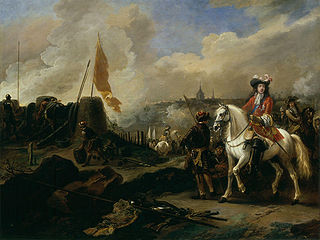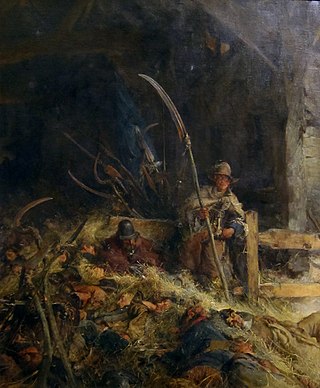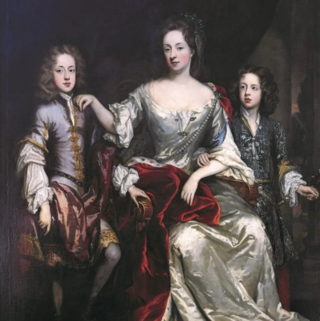
1685 (MDCLXXXV) was a common year starting on Monday of the Gregorian calendar and a common year starting on Thursday of the Julian calendar, the 1685th year of the Common Era (CE) and Anno Domini (AD) designations, the 685th year of the 2nd millennium, the 85th year of the 17th century, and the 6th year of the 1680s decade. As of the start of 1685, the Gregorian calendar was 10 days ahead of the Julian calendar, which remained in localized use until 1923.

Charles II was King of Scotland from 1649 until 1651 and King of England, Scotland, and Ireland from the 1660 Restoration of the monarchy until his death in 1685.

George Jeffreys, 1st Baron Jeffreys, also known as "the Hanging Judge", was a Welsh judge. He became notable during the reign of King James II, rising to the position of Lord Chancellor. His conduct as a judge was to enforce royal policy, resulting in a historical reputation for severity and bias.

James Scott, 1st Duke of Monmouth, 1st Duke of Buccleuch, was a Dutch-born English nobleman and military officer. Originally called James Crofts or James Fitzroy, he was born in Rotterdam in the Netherlands, the eldest illegitimate son of Charles II of England with his mistress Lucy Walter.

The Battle of Sedgemoor was the last and decisive engagement between the Kingdom of England and rebels led by the Duke of Monmouth during the Monmouth rebellion, fought on 6 July 1685, and took place at Westonzoyland near Bridgwater in Somerset, England, resulting in a victory for the English army.

The Monmouth Rebellion, also known as the Pitchfork Rebellion, the Revolt of the West or the West Country rebellion, was an attempt to depose James II, who in February 1685 succeeded his brother Charles II as king of England, Scotland and Ireland. A group of dissident Protestants led by James Scott, 1st Duke of Monmouth, eldest illegitimate son of Charles II, opposed James largely due to his Catholicism.

Duke of Buccleuch, formerly also spelt Duke of Buccleugh, is a title in the Peerage of Scotland created twice on 20 April 1663, first for James Scott, 1st Duke of Monmouth, and second suo jure for his wife Anne Scott, 4th Countess of Buccleuch. Monmouth, the eldest illegitimate son of King Charles II, was attainted after rebelling against his uncle King James II and VII, but his wife's title was unaffected and passed on to their descendants, who have successively borne the surnames Scott, Montagu-Scott, Montagu Douglas Scott and Scott again. In 1810, the 3rd Duke of Buccleuch inherited the Dukedom of Queensberry, also in the Peerage of Scotland, thus separating that title from the Marquessate of Queensberry.

Charles Middleton, 2nd Earl of Middleton, Jacobite 1st Earl of Monmouth, PC was a Scottish and English politician who held several offices under Charles II and James II & VII. He served as Secretary of State for Scotland, the Northern Department and the Southern Department, before acting as Jacobite Secretary of State and chief advisor to James II and then his son James III during their exile in France.

The Rye House Plot of 1683 was a plan to assassinate King Charles II of England and his brother James, Duke of York. The royal party went from Westminster to Newmarket to see horse races and were expected to make the return journey on 1 April 1683, but because there was a major fire in Newmarket on 22 March, the races were cancelled, and the King and the Duke returned to London early. As a result, the planned attack never took place.

Lucy Walter, also known as Lucy Barlow, was the first mistress of King Charles II of England and mother of James, Duke of Monmouth. During the Exclusion Crisis, a Protestant faction wanted to make her son heir to the throne, fuelled by the rumour that the king might have married Lucy, a claim which he denied.

Anne Scott, 1st Duchess of Buccleuch was a wealthy Scottish peeress. After her father died when she was a few months old, and her sisters by the time she was 10, she inherited the family's titles. She was married to James Scott, 1st Duke of Monmouth, and the couple had six children, only two of whom survived past infancy.
Events from the year 1649 in England. The Second English Civil War ends and the Third English Civil War begins.

Henrietta Maria Wentworth, 6th Baroness Wentworth was an English peeress.
Events from the year 1679 in England.

Eusebius Andrews, December 1606 to 22 August 1650, was a London lawyer and Royalist during the Wars of the Three Kingdoms, executed for his part in a 1650 plot to restore Charles II of England. A prominent supporter of the Crown since the early 1630s, he was a determined conspirator who organised a number of Royalist risings in Cambridgeshire between 1642 and 1650.

A royal bastard is a child of a reigning monarch born out of wedlock. The king might have a child with a mistress, or the legitimacy of a marriage might be questioned for reasons concerning succession.

William Strode III was a wealthy English landowner, Member of Parliament, and aider of the Duke of Monmouth in the Monmouth Rebellion (1685).
James Crofts was an officer of the British Army.
Ann Smith was an English anti-Catholic political activist. A devout Baptist, she and her family sheltered the rebel 9th Earl of Argyll when he was in hiding in London and fled with him to the Spanish Netherlands in 1683. She lived with her husband in Utrecht and following his death funded Argyll's Rising in Scotland and the contemporaneous Monmouth Rebellion in England. She hosted fellow conspirator Elizabeth Gaunt in Amsterdam and received a royal pardon for her activism in 1686, after which time records of her life cease.














